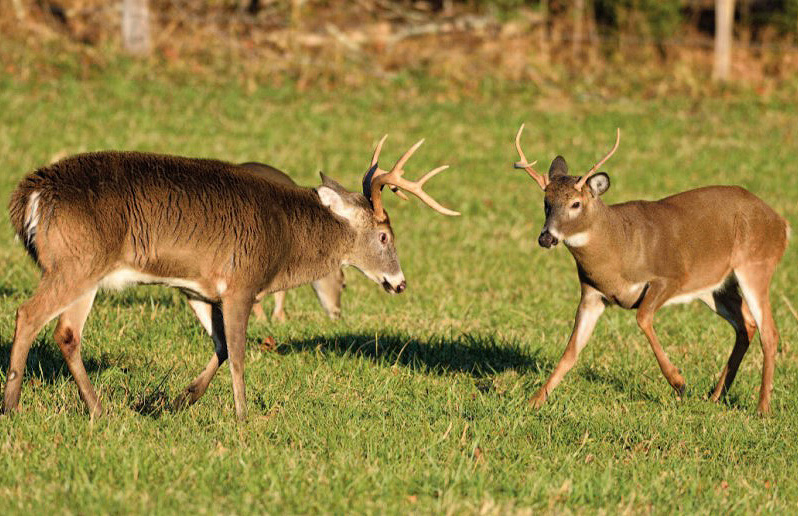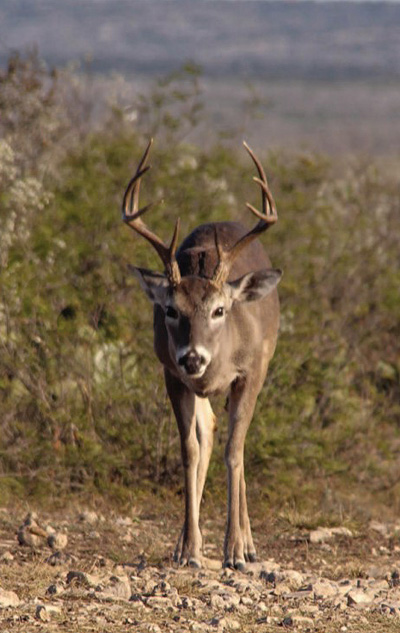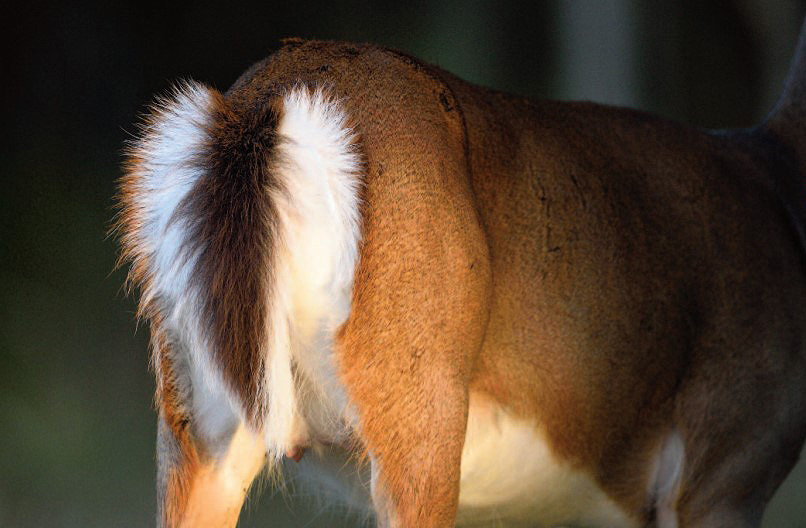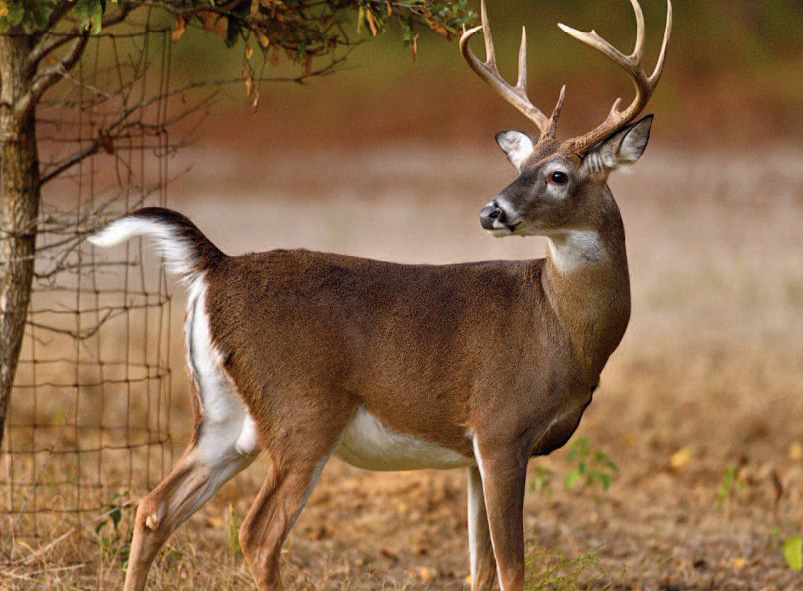Brad Fitzpatrick | Originally published in GameKeepers: Farming for Wildlife Magazine. To subscribe, click here.

It’s said that the bulk of interpersonal communication between humans is related via body language and not spoken words, so sending the right message to others is critically important. Facial expressions, body posture, simple gestures or eye movements tell a lot without uttering a word. Likewise, animals communicate using body signals as cues to indicate fear, dominance, aggression, or sexual receptivity, and this includes whitetail deer.
Most hunters know there are certain “tells” that indicate a whitetail has busted you, but there’s a great deal more to be learned from a whitetail’s body position and movements than whether or not the deer smells a rat. Learning to read the animal’s mood will also help you know whether or not your calling is working, whether the deer is preoccupied with rutting activity and oblivious to your activity, or perhaps that you may want to hold out on the shot because something larger this way comes.
Ultimately, all deer body language communicates a message to other deer, so you need to be able to decipher those codes whether the subject of the whitetail’s attention is a dominant buck or the odd-shaped creature standing on a platform twenty feet above the ground. To do this, I’ve divided deer behavior into four primary categories; relaxed, attentive, aggressive and fearful. Each one of these behaviors should elicit a different response from the hunter.
Relaxed

He doesn’t suspect anything and is in a natural, relaxed
state.
This is the state in which deer (at least theoretically) spend most of their time. A relaxed whitetail will relate obvious clues to an observant hunter. This starts with head and ear position. Though there are subtle variations from one population to the next and even one deer to the next, most whitetails rotate their ears frequently and raise and lower their head when they are calm. These moves are what you might classify as “casual;” there is no particular object of focus, just the typical scanning in all directions you might expect from a prey animal. The ears typically rotate and scan as a secondary defense to detect approaching predators from varying directions.
When relaxed, their neck should be relaxed, not upright in an alert position and you will often see that the deer is chewing, a certain sign of relaxation. The body position will be relaxed, and deer will step with low knees, wasting as little energy as possible as they move or feed. During the summer or early fall look for deer to kick or toss their head in an effort to rid themselves of flies – this is usually a sign that small biting insects are their biggest concern at the time.
The real key, here, is the tail. A deer that twitches its tail left and right is usually in a relaxed state. The hair on the body will also remain flat. The tail position and movement is a considerable indicator for us when we’re hunting because it can be easily seen from a distance. I’m sure most of you have seen it; when mother doe becomes alert and stops in her tracks, her fawn(s) will immediately freeze as well. If the doe determines whatever alerted her was a false alarm, 100% of the time she will indicate “everything is OK” to her offspring with a swish back and forth of her tail.
Attentive
Attentive deer occupy the space between simply pausing to pay attention to something of interest to fleeing an obvious threat. When something (human or otherwise) catches a deer’s attention expect it to focus its attention in the direction of the object. In addition to the eyes, deer will rotate its ears toward the subject and will likely toss the nose in the air in an obvious effort to gather more intel on the suspicious object. If the deer is acting this way and is not focused on you it may mean another deer is approaching— maybe that big buck that you’ve been trailing all year.
It’s important to understand that attentive and fearful are not the same. You’ll need more clues from the deer to determine whether it’s going to transition to an aggressive state, a fearful state or return to a relaxed state. Identifying this attitude is extremely important when you are calling deer. You’ll want to pay close attention when the buck you’ve been calling gives these signals that you have his attention. If he acts aggressively you need to be ready - he’s hooked and might be coming your way, so very little extra calling will be needed. Likewise, if the deer starts to spook, stop the calling and read additional signals.

Aggressive
This is the one type of behavior on the list that is almost exclusively directed toward other deer, and that’s a good thing because it means there’s about to be a fight. However, it may also be aimed at predators and other things deer may view as a threat.
Aggressive behavior in whitetails is marked by very specific behavior. The head is typically held flat or slightly above the shoulders and bucks will often tilt their antlers toward the object of their aggression. The tail is typically tucked tightly against the rump, which can also be a sign of fear, but an aggressive deer will usually also have hair that stands on end. The two keys are dropping ears and a stiff, heavy walk—both very obvious signs of aggression.
This aggressive display usually happens when neither buck backs down. The buck cocks its head slowly from side to side from his rival and advances at an angle with a sillylooking stiff-legged sideways walk. Its head is held erect, ears back, and chin down, cocking his head to one side or the other. Their hair will also be raised in this case. When viewing at a distance, when their hair bristles-up in this way, it looks like they’ve changed color. Once the confrontation has concluded, the more dominant buck will hold his head highest.
A deer that is ready to fight may not show all of these signs, but they will usually show at least some of them. For years individuals who owned private deer herds carefully watched for these indicators of aggression because, especially in domestic deer, it might mean that the owner is about to be attacked or a valuable buck may become injured.
A neighbor who owned a private deer herd noticed one mature buck had drooping ears, erect hair and a stiff gait while he was inside the buck’s pen one November morning. The buck suddenly launched into a full-fledged attack that resulted in broken ribs and punctured lungs before anyone could get him out of the enclosure. Had he recognized those signs of aggression immediately he might have escaped uninjured.
In the woods there’s very little chance that you’ll need to identify this behavior to protect yourself against attack, but learning to identify aggression in deer can teach you a lot about what’s happening with the animals. In the days prior to the rut bucks are still relatively social, but as the breeding intensifies so do the disputes between males.
An aggressive buck might indicate the rut is either in, or about to come into full swing. There may be receptive does in the area or territory in dispute. An antagonistic posture is also often taken by deer of all ages and both sexes when around a food source they are protective of, especially when food is scarce.
If you are calling and see a buck responding in such an aggressive manner it means you’ve done your job well. The deer is not simply curious, but rather furious, and chances are he’ll keep coming with very little extra coaxing. Additionally, this aggression is a sure sign that one buck recognizes the presence of another.
One morning while I was on stand a few years ago I witnessed a nice eight-point buck behaving very aggressively while he stood at the edge of a beech forest. I might have taken the shot but I wanted to see what had drawn the buck’s ire, and sure enough in a few moments a mature 150-class deer came walking from the trees.
While most often aggressive behavior will be displayed by older bucks, that is not always the case. Whitetails have different personalities just as people do, and sometimes a younger two or three year old just seems to have a chip on his shoulder. And as mentioned, when it comes to defending a food source or for a doe, when protecting her fawns, any deer can exhibit aggressive conduct. This is also the case when establishing the herd’s hierarchy or social ranking. All deer will display aggressive behavior in order to establish this pecking order.

Fearful
Unfortunately, this is the response most of us have experienced and learned to recognize. If a deer identifies a clear threat that represents an immediate risk they’ll run, almost always waving that signature “white-tail” above their backs as they go. But deer that are suspicious don’t always bolt at the first hit of danger. Instead, they’ll act attentive with their head raised and ears and nose engaged, but they’ll couple this with other signs of anxiety.
The tail will often stay flat or may be raised above the back, and you don’t have to spook very many deer before you witness their foot-stomping display of nervousness. This stomping of the foot serves to loudly alert other deer that there is a potential threat, and the stomping may be directed toward the potential threat in order to make the predator move. In addition, the foot stomping behavior leaves an olfactory warning via the interdigital gland on the deer’s foot. Deer often snort as well, giving a sharp wheeze through the nose that is often accompanied by other signs of fear like bounding and tail waving. This action may also clear the nose as well and allow the deer to detect faint odors that might warn of danger.
These signs don’t always immediately mean that a deer has busted you. In fact, deer wheezed and stomp for a variety of reasons, often because they simply don’t know what it is they’re looking at and are trying to gather more information while putting all other deer in the area on high alert. It’s usually that they’ve seen something and can’t fully smell what it is, or heard something and can’t quite smell what it is. Their sense of smell is a sense that is trusted completely. Oftentimes they will wait until they confirm danger with their olfactory system before they are fully alerted.
In Oklahoma, I witnessed a group of does wheeze, stomp, and wave their tail flag for the better part of twenty minutes as a bobcat slunk along a tree-line. The deer alerted almost continuously, but they never left the area, though they maintained a safe distance from the cat as it slipped through the trunks of the trees. Interestingly, there were other deer on an adjacent field that listened to the commotion without moving, but once the deer closest to the cat stopped raising a fuss the other deer went back to feeding, presumably without ever knowing what had happened.
The key, in these situations, is to remain absolutely still. Trust your stand setup and trust your camo, hoping that the thermals don’t betray your presence. There’s a chance that you won’t be busted if the deer don’t get a clean burst of your odor and your frozen stature convinces them that their eyes are simply playing tricks on them. The worst thing you can do in this situation is try to make a quick shot. You will lose a “Mexican standoff” with a whitetail every time.
There are other obvious body language signs that can tell us a great deal. The tail of a doe cocked off to one side can indicate when she’s ready to breed, or the way an animal acts when its shot can be an indicator of where the deer has been hit.
Typically a doe in estrus will hold her tail straight out and stiff, sometimes cocked off to one side. This posture often indicates her readiness to breed. In addition to this, she may also prance around nervously, especially if there are bucks somewhere nearby.
You’ve probably also made a shot and seen the so-called “mule-kick” or other behavior, giving you an indicator where the animal has been hit. Some have unfortunately seen the frantic tail twitch that usually means the animal has been hit in the guts. Not to be confused with the content tail swish mentioned earlier, this is a very rapid, jerky “tail spasm” almost.
Deciphering the body language of whitetails is an art. It can only be learned by watching and observing whitetails. The more you observe, the more you learn and the easier it will be to interpret a buck’s next move.































